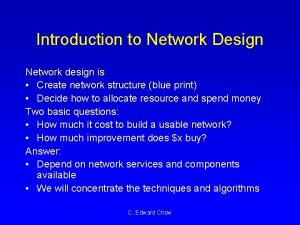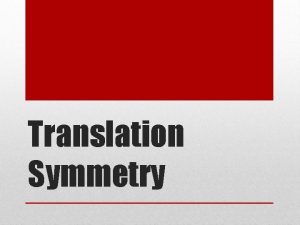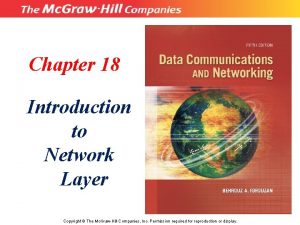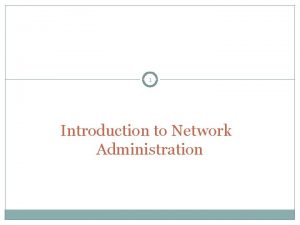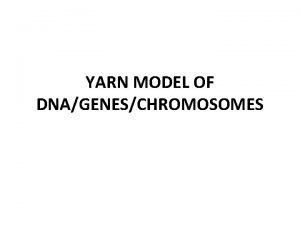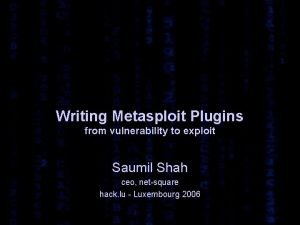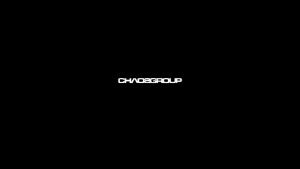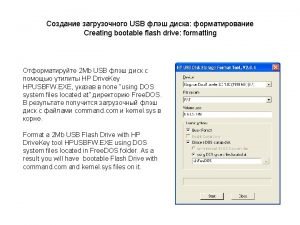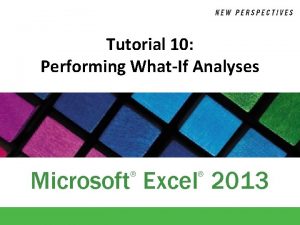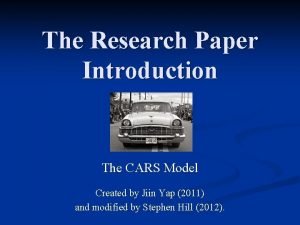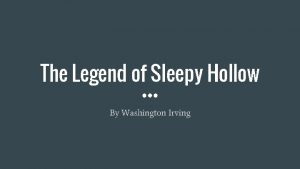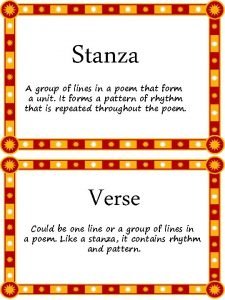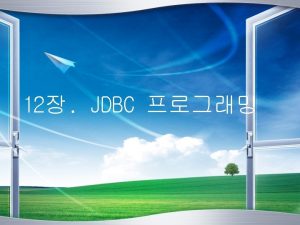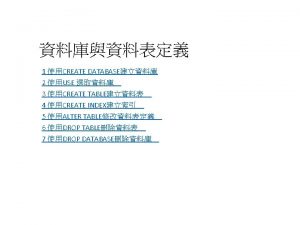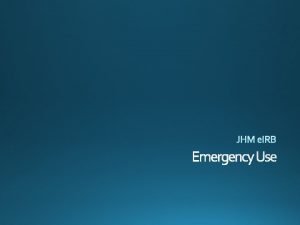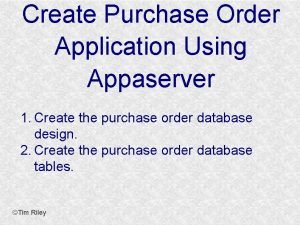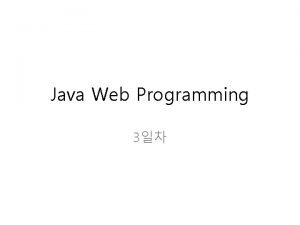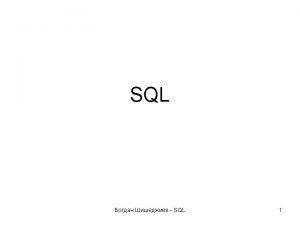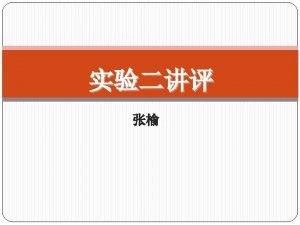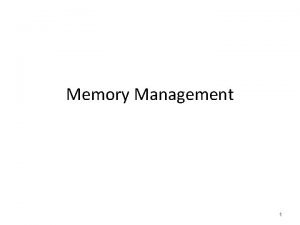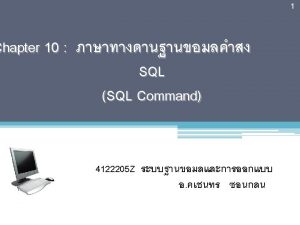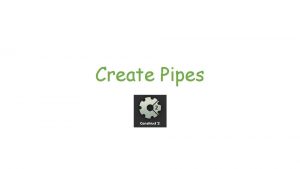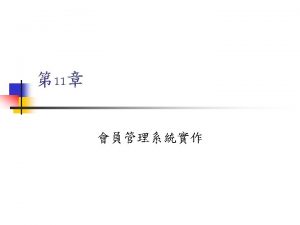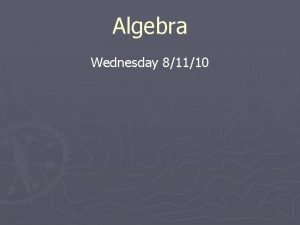Introduction to Network Design Network design is Create


































- Slides: 34

Introduction to Network Design Network design is • Create network structure (blue print) • Decide how to allocate resource and spend money Two basic questions: • How much it cost to build a usable network? • How much improvement does $x buy? Answer: • Depend on network services and components available • We will concentrate the techniques and algorithms C. Edward Chow

Network Evaluation • Every network has three characteristics: – Cost – Performance – Reliability • First we need to find agree-upon quantitative numbers. • Based on the quantitative numbers of these characteristics, we can evaluate different design alternative by ordering them and ruling out losers. C. Edward Chow

Example 1 • Four designs for a network design problem C. Edward Chow

Cheap Network (by Intrepid) 10/31/2020 C. Edward Chow 4

Messy Network 10/31/2020 C. Edward Chow 5

Rank Designs by Attributes 10/31/2020 C. Edward Chow 6

Justify the Designs • There can be factors that decides the final choice: Whether the company is expanding • Maybe the proposed designs are not as expected. • In outsourcing situation, you may ask for redesign • You may not have to serve as designer but as an evaluator. C. Edward Chow

Compare Designs 10/31/2020 C. Edward Chow 8

What is more important, Performance or Cost? • 150 cashiers $13, 725/month • CEO $152, 500/month • One user my justify the building a high performance network 10/31/2020 C. Edward Chow 9

Two-Location Problem • • • It is called “Hello World” of Network Design. It is undaunting yet interersting problem! Design a network connecting two locations, 200 km apart. Anagon city with 5 employees, Bregen with 10. Each employee – call other site 4 times/day, avg. 5 min. each. 4*5*15=300 min/day – call others in the same office 10 times/day about joint work, each last avg. 3 min. 10*3*15=450 min/day Note here we are not using C(10, 2)+C(5, 2) for the # of calls • How can we best provide the communications between the two cities C. Edward Chow

Cost of Network Services and Components • Network equipment purchase is typically amortized at 3% per month. • The PBX Private Branch Exchange would cost $60/month C. Edward Chow

Public Switched Telephone Network Solution 10/31/2020 C. Edward Chow 12

Cost of PSTN Solution Assume 21 2/3 work days=65/3 days Local call: 450 min/day*0. 05$/min*65/3 day=487. 5$ Long distance call; 300 min/day*0. 4$/min*65/3 day=2600$ 10/31/2020 C. Edward Chow 13

Utilization Analysis • 5 employees at Anagon place 4*5 min*5=100 min calls/day to Bregen • 10 employee at Bregen place 4*5 min*10=200 min calls/day to Anagon • 300 min long distance calls are shared among 5 employee at Anagon. • That is 300 min/5=1 hour/employee/day on long distance. • For 8 hour day, each phone at Anagon is busy 25%=2/8? of the time. While phone at Bregen is busy 18. 75%=1. 5/8? Low Utilization • Resaon: Each employee at Anagon makes 10*3 min/day=30 min local call, but it will tie up other employee’s line. Assume no conference call. Therefore each line is 30 min*2=1 hour/day is busy on local call. C. Edward Chow

Design Principle 2. 1 • Good network designs tend to have many wellutilized components. C. Edward Chow

PBX Solution $487. 5/month for local calls saved With$60*2=$120 amortized PBX cost, we actually save $367. 5/month Reliability degraded? ! Performance? 10/31/2020 C. Edward Chow 16

Reducing Trunks at Bregen • • • There can be 5 intersite simultaneous calls. Reduce 10 outgoing trunks at Bregen to 5. $25/month*5=$125/month access fee saving. How can we reduce the cost further? Clue Study the usage pattern C. Edward Chow

Famous 2 camel hump Telephone Traffic Daily Pattern • Traffic measured in Erlangs. C. Edward Chow

Erlang: the Traffic Measure Unit Definition 2. 1 If call arrive rate=l and departure rate=m, Then the call intensity is E=l/m Erlangs. In honor of Danish Telephone engineer Erlang. Example 1. Calls arrive 2 per min. , and hold for an average of 3 min, then l=2 and 1/m=3, E= l/m =6 Erlangs. Note that hold time (H)= 1/departure rate; H=1/m. Apparently one line cannot handle this amount of traffic. When a call comes and all lines are busy, the call is blocked. How many lines can reduce the blocking probability to x%? C. Edward Chow

Erlang Calculation • In our 2 -location case, 15 places 4 long distance calls/day, each call last avg. 5 min. Assume 8 hr day • What is the call (traffic) intensity for the day? l=15*4 calls/8 hr = 15/2 calls/hr H=5 min/call =1/12 hr/call m=1/H=12 calls/hr = 0. 2 calls/min E=l/m=(15/2)/12=15/24=5/8 Erlangs. • Assume 20% of the traffic in the busy hour. What is the call intensity in the busy hour? l=60 calls/day * 0. 2 = 12 calls/hr = 0. 2 calls/min m=1/H=12 calls/hr = 0. 2 calls/min E=l/m=12/12=1 Erlang. C. Edward Chow

Queueing Theory for System with Loss • Assume a telephone system with multiple lines. – When a call comes and all lines are busy, the call is blocked. Unlike data network, calls are not buffered or queued if lines are not available. – Or, you can consider it is a finite queue, i. e. , after queue full (line busy), further call are blocked. How many lines can reduce the blocking probability to x% for a given traffic density? • Queueing theory can be used analyzed the telephone system’s performance, specifically the blocking probability. C. Edward Chow

M/M/2 Queue 10/31/2020 C. Edward Chow 22

Loss with m Lines (m servers, no queue) A: Arrive Rate; D: Departure Rate; E=A/D APk-1=k. DPk Pk=E/k * Pk-1 C. Edward Chow

Erlang-B Function 10/31/2020 C. Edward Chow 24

Calculating the Blocking • In 2 -location case, with busy hour, A=0. 2 calls/min, D=0. 2 calls/min. • When 1 call in progress, departure rate is 0. 2 calls/min • When 2 calls in progress, departure rate is 0. 4. C. Edward Chow

Design Intersite Link • Given we can tolerate x% blocking, how many lines we actually need? • Here E=1 (busy hour). Carried load=E(1 -B(E, m)). qi=fraction of load on link i. C. Edward Chow

Simplified Traffic Profile • Instead of 2 camel hump traffic pattern, simplify it to two levels: peak and off-peak. • 60 min*2*0. 4*(21+2/3)=1040 30 min*6*0. 4*(21+2/30=1560 C. Edward Chow

Reduce Cost by Using Leased Lines • Instead of charged by # of calls, pay monthly cost. • The leased line costs $275/month replacing two PSTN lines, one on each end, for a total of $50. • The calls placed on the leased line save $0. 4/min. • Strategy: Place calls on leased lines first. • Question: How many released lines should we use? • Let us figure out the cost saving of each leased line. • First focus on busy-hour analsys C. Edward Chow

Busy Hours Analysis for Leased Line Saving • What is the value of busy-hours traffic carried by a single leased line? • With 60 min/hour usage, traffic is E=60/60=1 Erlang. • From table 2. 3, the fraction of calls on a single leased line is 0. 5. The other half got blocked. • Saving on dialup cost: 0. 5*$1040=$520/month • The net equipment cost of leased line=$275 -$50 (replaced two PSTN lines)= $225/month. • The net cost saving = $520 -$225=$295/month • It is justifiable. C. Edward Chow

2 nd Leased Line Saving • • For busy hours, the 2 nd leased line will carry 0. 3 traffic. Dialup cost saving = 0. 3*$1040=$312/month. $312 > $225 still justified. The third leased line only carries 0. 1325 busy hour traffic. • Dialup cost saving = 0. 1325*$1040=$143/month. • We need to see if the cost saving of off-peak hour usage of the 3 rd leased line adds up to $225. C. Edward Chow

Off-Peak Analysis of 3 rd Leased Line • Off-Peak hours traffic = 30/60= 0. 5 Erlang. • The fraction of calls carried by the first leased line =B(0. 5, 0)-B(0. 5, 1)=1 -(0. 5*B(0. 5, 0))/(0. 5*B(0. 5, 0)+1)=2/3. • Cost saving for the 1 st leased line=(2/3)*$1560=$1040/month. • The fraction of calls carried by the 3 rd leased line =B(0. 5, 2)-B(0. 5, 3)=(1/13)-(0. 5*B(0. 5, 2))/(0. 5*B(0. 5, 2)+1) =1/13 -1/79=0. 0643. • Cost saving for the 3 RD leased line during off-peak hours =(0. 0643)*$1560=$100. 25/month. • $100. 25+$143=$243. 25> $225 justified! C. Edward Chow

Final Design C. Edward Chow

Cost of Final Design 2 PBX’ 3 leased lines 4 PSTN lines $3462. 5 -$1129. 75=$2332. 75/month saving C. Edward Chow

Homework #1 • Exercises 2. 1 & 2. 3 For Exercise 2. 1, design for handle busy hour traffic. Indicate how many lines will be needed and how many of them should be leased lines. You need to generate tables similar to Table 2. 3 and 2. 5 to guide your decision. Hint: You may want to use spreadsheet to calculate Tables 2. 3&2. 5 • Exercise A: Use Erlang-B function to decide # of modems for an ISP. Assume that it has 1000 customers, each connects once for 1 hour during the day. If the blocking probability of 0. 2 is acceptable, how many modems are needed in the modem pool? Note that this is 24 x 7 operation. C. Edward Chow
 Jika noel(create(q)) adalah 0, maka front(create(q)) adalah
Jika noel(create(q)) adalah 0, maka front(create(q)) adalah How to create an introduction for an essay
How to create an introduction for an essay Hook for intro paragraph
Hook for intro paragraph Introduction to network design
Introduction to network design Network systems design using network processors
Network systems design using network processors Proportion in hair design
Proportion in hair design Curved lines in hair design
Curved lines in hair design Strip pattern symmetry
Strip pattern symmetry Building blocks used to create the principles of design
Building blocks used to create the principles of design Essay structure
Essay structure Security mechanisms in cryptography
Security mechanisms in cryptography Introduction to network layer
Introduction to network layer Managing entity network management
Managing entity network management Introduction to network administration
Introduction to network administration Introduction to cryptography and network security
Introduction to cryptography and network security Introduction to cryptography and network security
Introduction to cryptography and network security Datagram switching vs virtual circuit
Datagram switching vs virtual circuit Topology in computer
Topology in computer Features of peer to peer network and client server network
Features of peer to peer network and client server network Network centric computing and network centric content
Network centric computing and network centric content Circuit switching disadvantages
Circuit switching disadvantages Create your own top level domain
Create your own top level domain Dna model yarn
Dna model yarn Pattern create metasploit
Pattern create metasploit Write a parable
Write a parable Work cited page example
Work cited page example Vray proxy
Vray proxy Scratch.mit.edw
Scratch.mit.edw Create bootable usb
Create bootable usb How to create a scenario pivot table in excel
How to create a scenario pivot table in excel Inferring speaker's tone mood and purpose
Inferring speaker's tone mood and purpose Cars model introduction sample
Cars model introduction sample Legend of sleepy hollow theme
Legend of sleepy hollow theme Imbalances in earth’s heat energy help to create weather.
Imbalances in earth’s heat energy help to create weather. Line vs stanza
Line vs stanza



